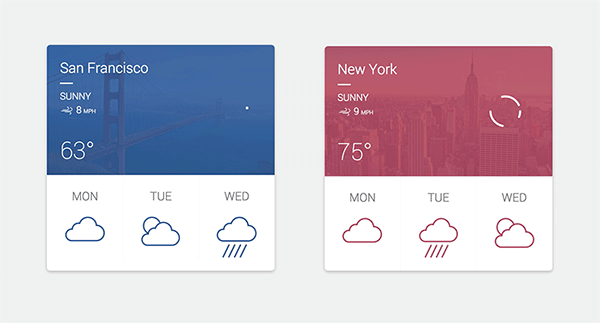

It would require to detect the y position of the item, and use ionicScrollDelegate to scroll to it. Here's a rough mockup of a technique stretching/scrolling an ion-item. Finally, you transition the opacity:0 and leave the route. Why an absolute named view? Because it will allow, with z-indexing, for the list to stay underneath the "item detail" view, so when the user closes/leaves it, you can roll back your animation, and the rectangle will shrink back to exactly the dimensions and position of the list item. The animation shown in the video seems pretty complex: the "item detail page" grows slower on the bottom and faster on the top, when the bottom item is clicked. Detect the x-y position of the list element that has been clicked ( an example, assuming you use AngularJS with jQuery), and you pass it to the "item detail" route (see above), so the rectangle grows with origins corresponding exactly to where the UI is a the moment of the click/tap.animate : here you have several choices, but here's one : use a ui-router absolute named view and wrap it in a div container with overflow:hidden, that has inital dimensions corresponding to the dimensions of a list item.This is an animation simulation for anyone interested in using this animation within any project doesn’t have to be Google related. retrieve the id of the clicked/tapped item (pass it to the function) Material design is filled with animations, specifically when you load a new element.Once the user clicks/taps the list element, it triggers the function (console test). Option 1Ĭreate a custom-made function that gets triggered on a list element being clicked/tapped, to place in your controller (or directive). It's quite large, and makes you wonder why Polymer doesn't get the same momentum as AngularJS. Polymer's ecosystem provides a lot of already-made components to build your app with.

Scroll to "Show me the magic!" on this page, and check these demos.

Good news seem to be that routes will have their own viewports and sibling viewports.ĪngularJS somewhat starts to embrace Polymer's web components concept. My feeling is the angular material team is already pushing like maniacs to bring this awesome tool to 1.0, and will take advantage of the new routing system in Angular 2 to provide some animations like the one you wish to attain out of the box.īut it's the bleeding edge of the bleeding edge, at least for the time being.
#Material design animation android
Material Design guidelines are simply guidelines, and are loose enough to be hacked - or strictly followed, in the case of Google's Android apps (in-house or not).

#Material design animation download
This could be achieved before (please check this answer or this DevBytes video by Chet Haase) but it was rather complex/hacky so it was included as a standard resource in Android L.Ĭheck the documentation for Activity Transitions in the L preview documentation, or the ActivitySceneTransitionBasic included as part of the android-L samples (also remember that you can download the L reference preview from here to get the documentation for the new methods).Angular-material is not a magic wand that replicates the animation guidelines of Material Design. The canonical example would be a Gallery app, when transitioning from the grid that shows all images to displaying a particular one. of particular views changing positions or dimensions as part of an activity transition). The idea is to achieve the visual effect in those videos (i.e. The transition is then included as part of the ActivityOptions object passed to startActivity(). In particular, there transitions can contain shared UI elements, which indicate mappings between "corresponding" views in the caller and called activities. Android L introduces Activity Transitions as part of the Animation framework. I guess they could be implemented with fragments but I might suspect they would be separate activities.


 0 kommentar(er)
0 kommentar(er)
